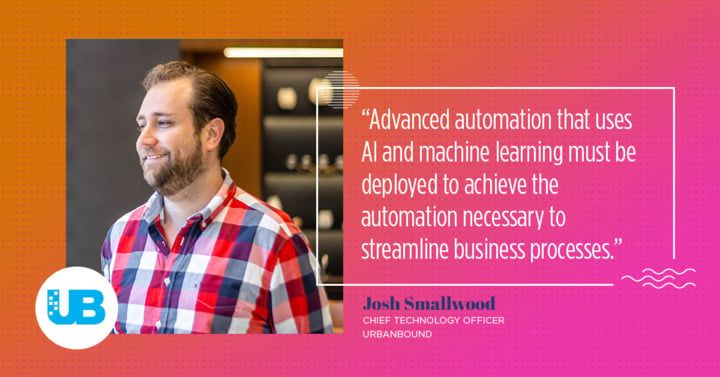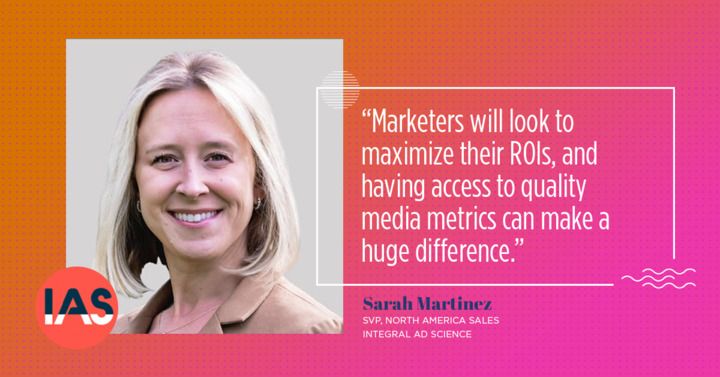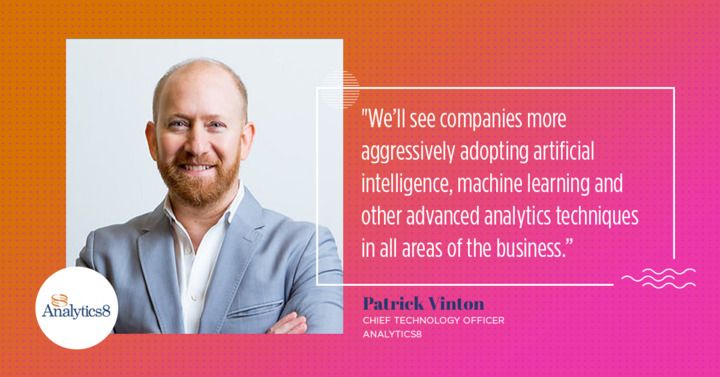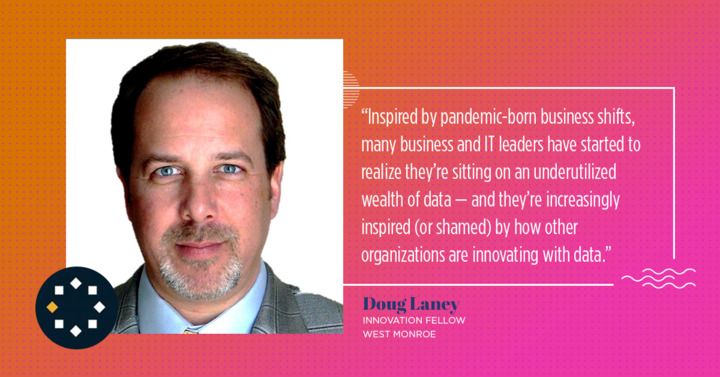Technology is constantly evolving, and if the utter chaos of 2020 has taught us anything it’s that it will continue to evolve and adapt no matter what’s thrown our way.
From enhanced cybersecurity measures to artificial intelligence-led manufacturing and the mass deployment of 5G internet, it’s clear that this year brought about innovative solutions — and industry leaders are confident that 2021 will bring about even more.
Whether it’s increased use of cloud-based analytics tools, finding creative ways to monetize data assets or implementing advanced automation techniques, opportunities abound for the tech industry. So, in order to get a glimpse into the technology trends they’re expecting to see in 2021, Built In Chicago asked five local leaders to share their thoughts — and explain how they think it’ll affect their respective industries.

Advanced Automation Techniques
“The trend I’m watching for in 2021 involves automation,” Smallwood said. “COVID-19 has renewed the focus on automation, with companies needing to use technology to automate back-office processes and help employees work from anywhere. Advanced automation that uses AI and machine learning techniques must be deployed to achieve the automation necessary to streamline these business processes.
“The relocation management industry still contains many manual processes for everyone involved. As a technology company, our goal is to deliver an end-to-end relocation experience through technology that reduces the stress of relocating employees and offloads work from their employer. Automation is the key to reaching that goal.
“The most significant impact we can have on relocating employees is to help reduce stress during the move process. We have spent a great deal of time streamlining the move process and providing employees the support they need through our SaaS application. In 2021 and beyond, we will be using the data we have collected to enhance our move process further and create an adaptive experience based on the relocating of an employee’s individual needs.
“One of the best ways to reduce our clients’ workload is to automate their back-office operations through integrations between our SaaS application and the suite of products they use every day, thereby reducing our clients’ burden. In 2021, we plan to continue expanding our integration partners and integration capabilities, making it easier and faster for our clients to get the data they need.”
Josh Smallwood is CTO of Urbanbound, a software and HR tech company.

Remote-Viable Processes
“The switch to full-time remote and hybrid work will continue to reshape the tech industry and the way the world works in 2021 and beyond,” Brown said. “This shift to an increased remote workforce impacts office culture, property choices, urban centers, transportation, online collaboration technology and, ultimately, where people choose to be geographically located. The legaltech and compliance industries must enable remote and hybrid workers to conduct their e-discovery, investigations and document review work as securely and efficiently as they've done in physical offices. Courts and legal teams may also look to further enable remote-viable proceedings in order to scale access and speed to justice.
“Our platforms will need to continue to collect and ingest new and rapidly scaling sources of data that drive e-discovery including data from online collaboration platforms like Slack, Zoom and Teams. Further, once in our platforms, we’ll need to render collaboration technology content in unique and relevant ways for our investigative teams to easily organize the data, discover the truth and act on it.”
Chris Brown is the chief product officer at Relativity, a global software company.

Optimizing Ad Spend
“Consumers have embraced connected TV (CTV) and streaming platforms as the future of television, with 91 percent of users reporting watching some form of ad-supported CTV content,” Martinez said. “Within the next year, we expect to see advertising on CTV take off as it moves further into the programmatic space, opening doors for advertisers to reach expansive audiences in a more engaging way. The biggest difference between a linear TV ad and an ad for CTV is the measurability. More than ever before, marketers are looking to maximize the return on their investments, and having access to quality media metrics can make a huge difference when it comes to optimizing their ad spend.
“CTV has quickly become one of the most premium environments for advertisers, but there are still improvements to be made. Our research shows that solutions like frequency capping to reduce repetitive ad placements and the ability to skip certain ads could help to enhance user experience. Access to deeper contextual insights will also give advertisers the ability to give consumers a cohesive and personalized viewing experience. We’ve just brought on our new Chief Product Officer Tom Sharma to hone our first-to-market CTV solution for programmatic spaces with features like brand safety.”
Sarah Martinez is SVP at Integral Ad Science, an advertising technology company.

Cloud-Based Analytics Tools
“In 2021, we’ll see an increased acceleration of data and analytics assets and workloads being moved to the cloud,” Vinton said. “While cloud computing and storage are not new concepts, companies are now looking to the cloud as a way to gain a strategic advantage in the market versus simply seeing the cloud as a vehicle to offload resources and reduce cost. Over the last decade, companies moved their operational systems from on-premise to the cloud, so it only makes sense that the analytical systems that comb through the data generated by operational systems should also reside in the cloud.
“While this is a compelling reason to move to the cloud, it alone does not make companies more competitive. Cloud-based analytics tools make it easier and more economical to complete what used to be considered complex tasks — augmenting internally-generated data with third-party sources, running complex queries on structured and unstructured datasets, embedding analytics into internal portals or customer-facing websites, and deploying resource-intensive machine learning models. What used to take months of planning and enormous upfront costs can now be kicked off almost immediately with a few mouse clicks on disposable, pay-as-you-go resources.
“Companies will take more risks because they can be more nimble with their analytics — traditional barriers to entry (upfront costs and resources) are effectively eliminated when tapping into the cloud. We’ll see companies more aggressively adopting artificial intelligence, machine learning and other advanced analytics techniques in all areas of the business to innovate, answer burning questions, adjust pricing models and even launch new offerings. If 2020 has taught us anything, the world is dynamic and unpredictable, and a cloud-based data and analytics platform helps companies adapt to changes quickly.”
Patrick Vinton is CTO of data and analytics consulting firm Analytics8.

Monetizing Data Assets
“I’m continuing to keep my eye on the scramble for companies to monetize their data assets,” Laney said. “Inspired by pandemic-born business shifts, many business and IT leaders have started to realize they’re sitting on an underutilized wealth of data — and they’re increasingly inspired (or shamed) by how other organizations are innovating with data.
“We’re helping these leaders understand that data doesn’t have to be sold or licensed directly to generate significant measurable economic benefits, but rather there are numerous ways to benefit from data, both internally and externally. Companies we’ve worked with have discovered dozens of new data-driven business ideas, with some yielding $100 million or more in untapped value. Ideation may be the easy part, whereas data compilation, preparation, analysis and access methods require a host of foundational data management and analytics technologies.
“For IT and business consultancies like West Monroe, data monetization is as much a boardroom topic as it is a technology topic. Senior executives acknowledge that even though data is not a balance sheet asset, it should be treated and wielded like one if the business is going to thrive in the information age and digital economy. For us, it changes the discussion from, ‘Yes, we can help you build a data lake and advanced analytics capabilities,’ to, ‘Yes, we can apply data and analytics in new and innovative ways to improve efficiencies, revenue and compliance throughout your business and your extended business ecosystem.’ When these discussions shift, the data warehouse or data lake and analytics capabilities become self-funding initiatives.”
Doug Laney is an innovation fellow at IT and business consultancy West Monroe.




